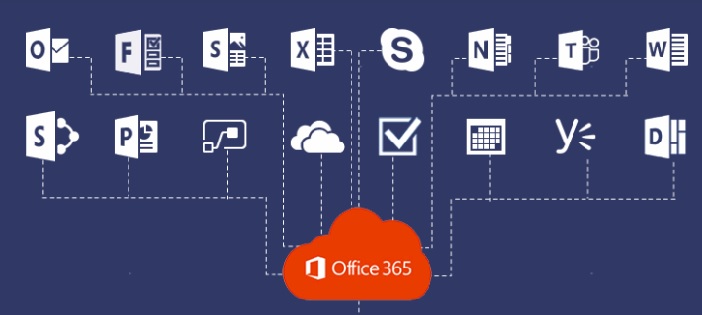Even after years of its launch as a trendsetting enterprise application, Microsoft Office continues to dominate both domestic and business circuits and is miles ahead of its competitors. With time, Microsoft made a winner move by clubbing the capabilities of the Office suite with the possibilities of the cloud, renaming the application as Office 365. With an increasingly high number of businesses partnering with Office 365 migration consulting services for shifting to the Office 365 setup, all migration factors including the prerequisites, advantages, risks, change management, and best practices must be considered to ensure a successful migration.
Here’s What Makes Office 365 Migration Indispensable

A seasoned Office 365 migration consulting services provider can help users unleash the true potential of the Office 365 setup for optimum business outcomes. Some of the best advantages of opting for Office 365 migration are discussed below.
Close Integration with the Microsoft Stack
Microsoft has been the undisputed leader of the enterprise solutions race for decades. Few individuals are unaware of its productivity stack comprising Office 365, Teams, Power Platform, Outlook, SharePoint, and many more which make it a complete ecosystem with different components closely integrated. For Office 365, its tight integration with other Microsoft tools is what makes it a delightful experience for users and ensures a smooth transition from the on-premises environment to the cloud. Even for non-Microsoft applications, Office 365 offers connectors that easily make the application talk to other external systems.
Highlights
- Since the Office 365 setup offers native support for all modern systems including Windows, Android, iPhone, and Mac systems, individuals can use the device of their preference to connect to key corporate tools and applications without extensive setup efforts.
- The use of familiar Microsoft tools eliminates the need for change management and costly training sessions that would otherwise be an unavoidable costly affair.
Office 365 Offers Scalability
An attraction of cloud applications is the high degree of flexibility and the wide array of subscription options that users get to choose from. Cloud negates the need for maintaining local email servers or local drivers which is an extensive and resource-hungry task. Whereas scaling operational capabilities is an enormous task that involves costs, efforts, and even halting of operation, with Office 365, it’s just the matter of a few mouse clicks to choose the right subscription plan. Users can mix and match different combinations of apps that can be tailored to the specific needs of their business. Rather than paying for the entire suite that also contains tools that are hardly used by the buyer, users can pay only for the ones they need and keep adding more apps as their needs evolve.
Highlights
- Substantial overheads can be saved when additional servers or networking equipment are erased from the picture. Also, Microsoft’s cloud platform Azure promises unrivaled uptime of Office 365 apps to ensure unhindered business operations.
- It eases the life of IT managers as instead of investing time and resources in the maintenance of local applications, they just have to adjust their Office 365 subscription plan to meet their business requirements.
Operational Agility
When businesses run on disparate systems that cause data silos, mismanagement and low productivity are among the early repercussions. Although this has never been a secret, the IT leadership was somewhat helpless until the revolutionary innovation of SaaS (software as a service) took the business world by storm. As one of the pioneers of SaaS, Office 365 delivers an unprecedented boost to operations with its range of purpose-built apps such as Microsoft Yammer and Teams that allow unhindered collaboration within and outside the team.
Highlights
- Office 365 mobile access ensures unhindered team collaboration even while in transit. It also makes video conferencing, online meetings, and round-the-clock monitoring a cakewalk for business leaders and managers.
- Functionalities such as document sharing, simultaneous editing of files, and document version control discard all chances of confusion and data loss. This advantage can be extrapolated to customer services and ticketing systems backed by case tracking and access to conversation history.
Watertight Security
For those new to cloud technology, data security is often a concern. They will vouch for the security features of their home-grown system rather than storing their business data on a virtual platform. However, the reality is that cloud storage is perhaps the safest form of data security. Office 365 is known for its digital threat protection measures designed to identify data threats including malware, ransomware, and harmful links, ensuring that data stays secure and only authorized people can access it.
Highlights
- Multi-factor authentication (MFA), or the two-step verification offers an additional security layer that requires the user to present a second form of data authentication to confirm their identity to access Office 365 resources. Furthermore, systems, files, and online activities are protected comprehensively from viruses, malware, and spyware with Windows Defender.
- Customers can use data loss prevention (DLP) policies to manage sensitive information. They can leverage Exchange Online Archiving and Office 365 Message Encryption to ensure the safety of data in Outlook.com, Yahoo!, and Gmail, and other email services. The advanced device management features allow owners to give controlled access to others.
Risks Involved in Office 365 Migration
Every good thing comes with a price attached to it and Office 365 is no different. While the advantages the cloud-hosted application offers cannot be rivaled, certain prerequisites must be met before attempting a leap from a local environment to Office 365. As the trend of organizations migrating to Office 365 gains further momentum, there is an undeniable need to address certain critical risks involved in the process. Once the downsides are covered adequately with meticulous preparation, users can be sure of a successful transition to Office 365. Here’s a closer look at the most serious ones and the best way out around them.
An Underprepared Execution
It’s probably the most common mistake that first-time cloud users tend to commit. Underplaying the pivotal role of a foolproof migration plan can be the cause of disastrous outcomes for the client. A flawed migration has the potential to screw up the transition as well as pose long-term operational threats. Executing a migration without governance, security, auditing, productivity plan, and license management is suicidal. There must be a detailed roadmap of the migration plan encompassing not just the migration of users, data, applications, and services but also other critical factors such as a smooth process, change management, and data transfer and security.
Best Practices
- It’s a must to have the buy-in of the end-users. Arrangements must be done to train stakeholders such as the DevOps team on the new environment and eliminate all skill gaps in the organization.
- Rather than counting on the relatively inexperienced in-house team for migrating SharePoint to Office 365, a managed service provider (MSP) who can help in SharePoint and Exchange migration to Office 365 is the best bet for organizations for harnessing the possibilities of Office 365.
- The management must be certain of why it wants to make the move. There must be a content-level analysis and an audit of the current system for insights into the structure of the data farm or file server.
No Backup Plan
Office 365 is perhaps the most versatile one-stop enterprise solution available today that seamlessly hosts workflows, supports collaborations, stores data, and analyses information. Although Office 365 is robust and highly reliable, backed by Microsoft’s security policies, the need for a data backup plan is real and serious. In the rare event of loss of any data, retrieving is possible but the process is long and complicated and the process depends on the retention policies of the user.
Best Practices
- Leverage Office 365’s data loss prevention tools and set up Data Loss Prevention in the Security and Compliance Center to protect sensitive data by identifying documents with such information and preventing any unauthorized sharing.
- As Microsoft’s native data recovery tools have certain limitations, customers must have a third-party solution for not just data backup in the case of an incident, but also to sync back in-step with Office 365 when the issue is resolved.
- It’s a prudent choice to run the old system parallel to the new one until the data integrity of the new environment is tested. Furthermore, an experienced Office 365 migration services partner can help clients to granularly recover mailboxes and folders, and migrate emails to Office 365 even without recovering an entire Microsoft Exchange Online account first.
No Plan for Auditing & Forensics and License Management
Organizations with on-premises applications rely on their IT team for auditing and log retention and analysis. However, the same cannot be claimed for Office 365 which comes with limited log retention capabilities and whose native tools make log analysis somewhat difficult. Office 365 allows log retention for only 90 to 180 days, thus limiting the time for addressing security concerns or identifying breaches through forensic audits. Another source of concern stems from not having a rigorous process for determining the license needs of the organization and compensating that with just an estimate to identify the level and volume of the licenses required, thus adding to the costs.
Best Practices
- There must be long-term log retention that would help spot breaches even before they occur. A well-executed forensic audit can identify the source of breaches and help prevent undesirable events. A seasoned Office 365 migration partner can help its client with a granular level audit-plan.
- Uncovering of real-world Office 365 usage in the organization and its licensing metrics across departments as part of the requirement analysis should be carried out by the Office 365 email encryption setup
- The IT team must exercise extreme caution while selecting the Office 365 plan by mapping the organizational needs to the available plan. Upgrades must be analyzed carefully since a wrong purchase can add significantly to the operational overheads.
Missing Out on a Post-migration Strategy
A complete Office 365 migration checklist ends with a solid post-implementation plan that some organizations fail to consider or choose to ignore. If a productivity boost is a primary goal that the management is eyeing, it’s needless to say that the end-users of the new application must be willing to cooperate. Some staff members are certain to resist the change while others would readily welcome it. Some might have a difficult initial phase trying to adapt to the system while it might be a piece of cake for the rest. If the IT leadership doesn’t intervene at this critical juncture, the efforts of the organization might not bear the sweetest fruits.
Best Practices
- Arrange for extensive training sessions to help employees adopt the new system and set cut-off dates for the use of the old system. The management must highlight the immense possibilities of the cloud that can help ramp-up staff productivity.
- The ongoing education should feature from the onset by testing out the readiness of the staff. Ongoing sessions to introduce new features and tools, emphasizing how each will benefit the employees must be a regular feature during the initial days.
- The management must announce incentives and penalties to motivate the staff to accept the change. Another critical aspect is the ongoing Microsoft Office 365 support that’s required to ensure unhindered access to the application and instant troubleshooting to ensure the best user experience.
Migrating to Office 365 is a prudent choice but it also entails a series of critical Office 365 migration steps and challenges that must be navigated effectively to ensure success. This is also the reason why it’s best to join hands with an Office 365 migration services partner who is familiar with the intricacies of the undertaking and can ensure a bump less ride to the new environment.
Who We Are and Why Our Expertise Matters?
This article is brought to you by FlatworldEDGE, a Microsoft Office 365 integration, migration, implementation, and support services provider with over 10 years of serving global clients. Our Office 365 migration consulting experts customize the application to your specific operational needs and ensure the smoothest migration possible with our end-to-end migration services. Our flexible engagement models have been designed to offer cost benefits to our clients so that we can collaborate with them as a strategic partner to help them reap the maximum return on their investments.




